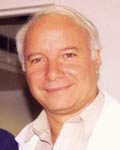 Prof Shimon Slavin
Prof Shimon Slavin
Head, Department of Bone Marrow Transplantation
and Cancer Immunotherapy Hadassah University Hospital Ein-Karem, Jerusalem
Prof. Shimon Slavin is
a renowned international leader in stem cell transplantation (SCT),
cancer immunotherapy and transplantation biology. Chairman of Israel’s
National Bone Marrow Transplantation Center. In addition, he has
been the director of the Baxter-Hadassah Research Center, director
of The Danny Cunniff Leukemia Research Laboratory and since 2001
has served as Medical Director of Cancer Immunotherapy at Cancer
Treatment Centers of America (CTCA). His contributions include a
new series of proprietary procedures and therapeutic tools for ultimate
treatment of an otherwise incurable broad spectrum of malignant and
non-malignant diseases.External Academic Positions
Visiting Prof.: Univ. of Minn.; Univ. of Texas at Dallas
Univ. of Singapore.
Memberships and Fellowships:
Amer. Immunological Soc.; Int'l Transplantation Soc.; Amer. Federation
of Clinical Res.; Int'l Soc. for Experimental Hematology; Int'l Gnobotic
Soc.; Amer. Soc. of Hematology; Amer. Rheumatism Assn.; Isr. Med. Soc.;
Isr. Immunology Soc.; Isr. Soc. for Allergy and Clinical Immunology
Research
Interests
Bone marrow transplantation (BMT); mechanisms and induction of
transplantation tolerance; new approaches to leukemia and solid tumor
therapy focusing on cell and cytokine-mediated immunotherapy in
experimental animals and man; hematopoiesis and enhancement of
hematopoietic reconstitution by cytokines and new growth factors.
Treatment and mechanisms of autoimmune diseases in experimental animals
and man.
2007 - Prevention of the Aging Process by Cell Therapy and Low Molecular Weight Compounds
Shimon Slavin and Aviv Gazit, Department of Bone Marrow Transplantation & Cancer Immunotherapy, Hadassah-Hebrew University Hospital, Jerusalem 91120, Israel
Despite consisting increase of life expectancy, the aging process, trauma, diseases, wear and tear, there is an increasing need for development of new methods for tissue repair and regenerative medicine. There is enormous variation in different organisms natural lifespan ranging from 2 weeks in worms to >150 years in turtles and certain deep-sea fishes. However, in addition to the major role of the genetic system, which cannot be replaced, in the aging process, there can be considerable variations of up to 30 times longer lifespan even in the same species, with essentially the same genetics, such as queen bee and male workers bees, for example. Overcoming or rather delaying the aging process may be accomplished by cellular replacement therapies, focusing on the use of multipotential stem cells, or by control of the aging process by interfering with intracellular signals associated with aging. In addition, experiments suggesting stem cell plasticity have created new hopes that regenerative medicine and life extension may become a clinical reality. Indeed, we have documented that adult and postnatal cord blood stem cells may be used for repair of bone and cartilage, as well as the composition of the brain and failing heart in rodents and man, respectively. Bone marrow derived donor cells were shown to replace necrotic host brain cells and improving signs of demyelinization in rodents with induced experimental autoimmune encephalitis (EAE) resembling multiple sclerosis in man.
As part of an intensive research aimed at understanding the causes of aging, mutations at about 50 genes were found to extend lifespan, based on mutations in several intracellular signal pathways. Of these the most universal as documented in worms, flies and mice, is IGF1 - a hormone similar to insulin, known to be important in growth and development. Genetic mutations that reduce IGF1 function have led to dramatic, >400% increase of lifespan, in nematodes. With the goal in mind to use low molecular weight compounds with anti-aging properties, we have synthesized several low molecular weight IGF1 inhibitors and investigated extension of mean and maximum lifespan in lower organisms, c. elegans nematodes and drosophila melanogaster flies. We discovered compounds in 6 different intra-cellular signal transduction pathways (3 of which are well established affecting genetically modified routes and 3 are new) with 30-60% mean lifespan extension in worms and nearly doubling of the maximum life span. Similar results were obtained in flies, but with somewhat lower lifespan extension capacity. Our agents may have enormous potential applications for extension of the longevity of stem cells and cells of various tissues, with the potential capacity to be applied clinically for prevention of the aging molecules of the skin and prevention or treatment of malfunction of different organs in the aged.